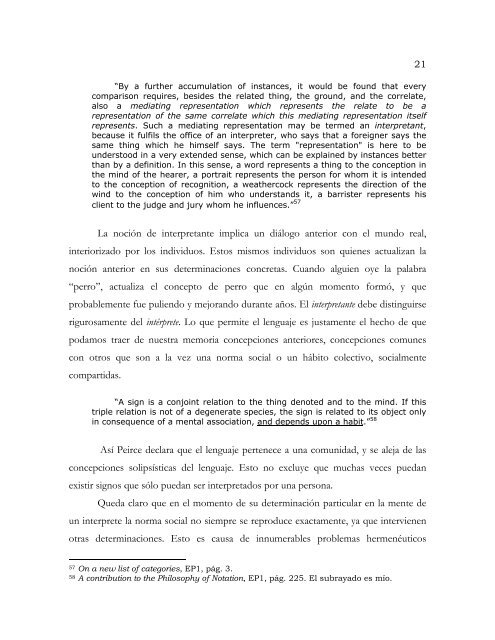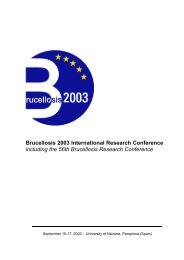Aportes filosóficos de Charles Sanders Peirce - Universidad de ...
Aportes filosóficos de Charles Sanders Peirce - Universidad de ...
Aportes filosóficos de Charles Sanders Peirce - Universidad de ...
Create successful ePaper yourself
Turn your PDF publications into a flip-book with our unique Google optimized e-Paper software.
“By a further accumulation of instances, it would be found that every<br />
comparison requires, besi<strong>de</strong>s the related thing, the ground, and the correlate,<br />
also a mediating representation which represents the relate to be a<br />
representation of the same correlate which this mediating representation itself<br />
represents. Such a mediating representation may be termed an interpretant,<br />
because it fulfils the office of an interpreter, who says that a foreigner says the<br />
same thing which he himself says. The term "representation" is here to be<br />
un<strong>de</strong>rstood in a very exten<strong>de</strong>d sense, which can be explained by instances better<br />
than by a <strong>de</strong>finition. In this sense, a word represents a thing to the conception in<br />
the mind of the hearer, a portrait represents the person for whom it is inten<strong>de</strong>d<br />
to the conception of recognition, a weathercock represents the direction of the<br />
wind to the conception of him who un<strong>de</strong>rstands it, a barrister represents his<br />
client to the judge and jury whom he influences.” 57<br />
21<br />
La noción <strong>de</strong> interpretante implica un diálogo anterior con el mundo real,<br />
interiorizado por los individuos. Estos mismos individuos son quienes actualizan la<br />
noción anterior en sus <strong>de</strong>terminaciones concretas. Cuando alguien oye la palabra<br />
“perro”, actualiza el concepto <strong>de</strong> perro que en algún momento formó, y que<br />
probablemente fue puliendo y mejorando durante años. El interpretante <strong>de</strong>be distinguirse<br />
rigurosamente <strong>de</strong>l intérprete. Lo que permite el lenguaje es justamente el hecho <strong>de</strong> que<br />
podamos traer <strong>de</strong> nuestra memoria concepciones anteriores, concepciones comunes<br />
con otros que son a la vez una norma social o un hábito colectivo, socialmente<br />
compartidas.<br />
“A sign is a conjoint relation to the thing <strong>de</strong>noted and to the mind. If this<br />
triple relation is not of a <strong>de</strong>generate species, the sign is related to its object only<br />
in consequence of a mental association, and <strong>de</strong>pends upon a habit.” 58<br />
Así <strong>Peirce</strong> <strong>de</strong>clara que el lenguaje pertenece a una comunidad, y se aleja <strong>de</strong> las<br />
concepciones solipsísticas <strong>de</strong>l lenguaje. Esto no excluye que muchas veces puedan<br />
existir signos que sólo puedan ser interpretados por una persona.<br />
Queda claro que en el momento <strong>de</strong> su <strong>de</strong>terminación particular en la mente <strong>de</strong><br />
un interprete la norma social no siempre se reproduce exactamente, ya que intervienen<br />
otras <strong>de</strong>terminaciones. Esto es causa <strong>de</strong> innumerables problemas hermenéuticos<br />
57 On a new list of categories, EP1, pág. 3.<br />
58 A contribution to the Philosophy of Notation, EP1, pág. 225. El subrayado es mío.
















